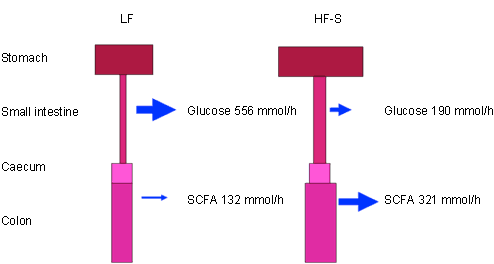Detailed knowledge of feed carbohydrate composition makes it possible proactive to modulate the uptake of carbohydrate derived nutrients (glucose, SCFA, and LA) and thereby influence the feeling of satiety and behavior of the animals. For instance, the ratio between starch and DF will typically be in the order of 2.5-3.0 in a concentrated diet for sows while it can be as low as 0.5 in high DF diets. The consequence of such a diet change is, as illustrated in Figure 1, that a larger proportion of carbohydrates is digested in the large intestine. Since the release of nutrients is slower in the large intestine than in the small intestine the diurnal variations in the uptake of energy will also be reduced as will the fluctuation in insulin secretion. A further consequence of substitution of starch for DF will be a higher gut fill in all segments of the gastrointestinal tract. Thus, sows consuming high DF diets can be expected to be satiated for a longer period of time brought about by the by the physical presence of digesta in the gut and the lower diurnal variation in energy uptake. These conditions can be expected to reduce the incidence of aggressiveness, stress and/or stereotype behavior in sows incurred by hunger as discussed in several papers.

Figure 1. Effects of feeding low-fibre (LF) or high fibre soluble (HF-S) diets on gut fill, and absorption of glucose and short-chain fatty acids. The concentration of starch was 517 and 216 g/kg dry matter of the LF and HF-S diets, respectively, and of dietary fibre 177 and 428 g/kg dry matter of LF and HF-S diets, respectively. Data from: Serena et al. (2008, 2009)
Not all DF sources, however, are equally suited to influence the provision of energy for the animals. The building blocks in DF polysaccharides are 10 common monosaccharides (pentoses, hexoses, and 6-deoxyhexoses) and since each monosaccharides can exist in two ring (pyranose and furanose) forms, and the sugar moity can be linked through glycosidic bonds at any one of their three, four or five available hydroxyl groups and in two (α or β) orientations, DF polysaccharides can adopt a huge number of three-dimensional shapes and thereby offer a vast range of functional properties. These factors will influence the solubility of DF and the physicochemical properties - water binding capacity (WBC), swelling and viscosity.
Of the DF rich feedstuffs we now know that DF sources that is characterised by a high content of soluble DF such as sugar beet pulp, potato pulp, pea hulls, soy hulls etc. are better suited to modulate the absorption profile of nutrients than are DF sources that are characterised by a high content of insoluble DF; brans and hulls from cereals. The reason for these differences is that the DF of the former groups of feedstuffs have the ability to swell and hold water in the DF matrix in contrast to the latter group of feedstuffs where the high degree of lignification and cross-linkages between polysaccharides limits the swelling and WBC. A further consequence of the differences in physicochemical properties between the two groups of feedstuffs is that the energy present in the DF polysaccharides can be broken down and absorbed to the animals to a higher extent in soluble than in insoluble DF sources where it is lost in the faeces.




